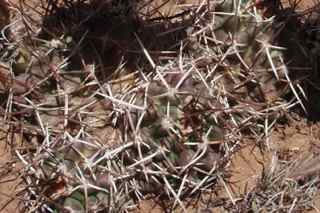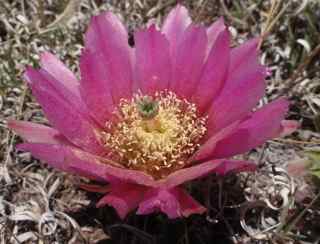|
|
 Spines Max Licher @http://swbiodiversity.org, Usage Rights: Creative Commons Attribution-ShareAlike (CC BY-SA) |  Flower Max Licher @http://swbiodiversity.org, Usage Rights: Creative Commons Attribution-ShareAlike (CC BY-SA) | | | | |
|
Origin:
Native Similar Species: E. fasciculatus, E. engelmannii
General Desc:
Loose clumps of fewer than 20 somewhat flaccid stems.
Identification notes: Purple to lavender flowers and a principal central spine that is not flattened at the base distinguishes this from other Echinocereus sp.
Height:
Less than 6 inches
Width:
Varies with stem number
Habitat Description: Limestone or igneous substrates, mostly south-facing hillsides.
Plant Communities:
Interior Chaparral, Semidesert Grasslands, Pinyon Juniper Woodland, Montane Conifer Forest
Elevation: 4500 - 7500 feet
Color:
Purplish-pink
Flowering Period:
May - Jun
Description:
Funnel-shaped, approximately 3-1/4 inches long flowers are borne on the upper part of the plant. Open during the day and closed at night.
Stem Color:
Green
Number of Stems:
Multiple
Stem Shape:
Cylindrical
Stems Segmented:
N
Stem Surface:
Ribbed
Stem Description:
Usually 1 - 20 uncrowded stems, often mound-like, ribs usually 9 - 10 per stem.
(structures unique to cacti, found on the stems, areas from which spines, flowers and fruits emerge)
Areole Description:
Circular, having white wool when young. One central spine, up to 16 spines per areole. Spine clusters interlock and fall away as a sheet at maturity.
Spine Color:
Generally in shades of brown and white or white with a brown stripe.
Spines Hooked:
N
Spine Description:
The central spine is dark brown to black becoming gray, slightly curved upward, rigid and not flattened. Radial spines are spreading, shorter, lighter colored, sometimes sinuous, often with a dark stripe on underside with different colors in same areole.
Fruit Color: Bright red or purplish, sometimes orange
Fruit Notes: Fruit is less than 2 inches long and spiny. Fruit color is bright or dull red or purplish-maroon, less often orangish-tan or purplish-orange. Pulp is magenta or red.
|
|


